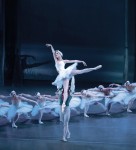A thick layer of white mist coats the stage floor. A ballerina emerges, head high, gliding swiftly as if floating across a lake, for now she is not just a dancer – she is a swan.
Friday and Saturday at Royce Hall, the Los Angeles Ballet performed its first segment in this season’s Tchaikovsky Trilogy: “Swan Lake.” A ballet composed by Pyotr Ilyich Tchaikovsky and first performed in the late 19th century, “Swan Lake” has been revived countless times all over the world while maintaining acknowledgement as a timeless classic – and rightfully so.
Swan Lake tells the love story of Prince Siegfried and Odette, a young maiden whom the evil and malevolent Von Rothbart has turned into a swan. Told in a four-act structure, the ballet moves swiftly with purpose and grace telling the story with intricate detail down to each step or flutter of a finger.
Considered a classic for so many years inevitably garners high expectations from audiences worldwide, but the Los Angeles Ballet was able to uphold and set standards for the complexity of the skills required by each of the dancers on stage. The choreography by Thordal Christensen and Colleen Neary, based on the work of original choreographers Marius Petipa and Lev Ivanov, was able to successfully breach these expectations. Through the use of highly emotional and poetic expression, the dancers illuminated the power of the story simply through the movements of their bodies.
The story of “Swan Lake” is both tragic and beautiful, and the dancers utilized both aspects in their storytelling. Allyssa Bross, dancing the role of Odette, spectacularly transformed her human body into that of a swan. With a crook in her wrist and a flutter of her feet, Bross changed shape and seemed to fly across the stage, transcending all belief that she was not indeed a swan.
Flight appeared as a common theme throughout the production with the ballet allowing for lightness of foot in graceful movements that were never rushed. In many ways, the structure of the performance, while seemingly rigid at times, allowed for more creative and bold choreography. The focus and passion enveloped on the faces of each dancer encapsulated the serenity and charming nature of the fairytale land they portrayed. With a dance so purposeful, it was as if each dancer had been transported back into the 19th century when the art of ballet was still a major form of storytelling.
While the tale of “Swan Lake” is by no means new and has been retold in numerous genres, the ballet is capable of accomplishing what films and novels cannot. The Los Angeles Ballet demonstrated its ability to surpass cultural limitations in its rendition of “Swan Lake.” The story is able to come across to all people of every age and every culture without the need for any verbal translation. The dancers executed a nearly flawless work written in a universal language.
It is true, however, that when one invests in a live performance, everything can’t go perfectly. At times an arm of one dancer was lower than another, and a bit of jewelry fell off one costume, but such mishaps also served as a reminder of the human element of the story that allowed the audience to relate on an earthly level. The combination of classical music and fluidly moving shapes induced a dreamlike state and made one forget how real the performance was.
This winter, the Los Angeles Ballet will return to Royce Hall for the holiday season to perform “The Nutcracker” and will finish off the Tchaikovsky Trilogy in the spring with “The Sleeping Beauty.” Bringing the classic to the present, the ballet is sure to continue bringing back the culture and stories of past centuries for many more years.
– Maryrose Kulick
